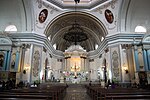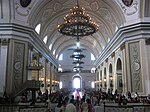Taal Basilica
| Taal Basilica | |
|---|---|
| Minor Basilica and Parish of Saint Martin of Tours | |
 Basilica facade in 2022 | |
Location in Luzon | |
| 13°52′51″N 120°55′29″E / 13.880705°N 120.924819°E | |
| Location | Taal, Batangas |
| Country | Philippines |
| Denomination | Catholic |
| History | |
| Status | Minor Basilica |
| Founded | 1572 |
| Founder(s) | Augustinians |
| Dedication | Saint Martin of Tours |
| Consecrated | 1865 |
| Architecture | |
| Functional status | Active |
| Heritage designation | National Historical Landmark |
| Designated | January 14, 1974 |
| Architect(s) | Luciano Oliver |
| Architectural type | Cruciform basilica |
| Style | Neo-classic |
| Groundbreaking | 1856 |
| Completed | 1878 |
| Specifications | |
| Length | 88.6 m (291 ft) |
| Width | 48 m (157 ft) |
| Nave width | 15.5 m (51 ft) |
| Number of domes | 1 |
| Administration | |
| Province | Lipa |
| Metropolis | Lipa |
| Archdiocese | Lipa |
| Deanery | Saint John the Evangelist[1] |
| Clergy | |
| Rector | Conrado G. Castillo |
National Historical Landmarks | |
| Designated | January 14, 1974 |
| Reference no. | No. 375, s. 1974 |
The Minor Basilica and Parish of Saint Martin of Tours, commonly known as Taal Basilica, is a minor basilica in the town of Taal, Batangas, within the Archdiocese of Lipa. It is considered to be the largest church building in the Philippines and in Asia, standing 88.6 meters (291 ft) long and 48 meters (157 ft) wide.[2] Martin of Tours is the patron saint of Taal, whose feast is celebrated every November 11.
History
[edit]Earlier churches
[edit]
In 1575, three years after the founding of the town of Taal in its old site near the shores of Taal Lake, work began on the construction of its first church by Diego Espinar with Martin of Tours as patron saint. The church was rebuilt in 1642 using stronger materials, but it was destroyed in 1754 along with the town of Taal in the largest recorded eruption of the Taal Volcano. This event led to transfer of the town and the church farther away from the volcano to its present site atop an elevated hill facing Balayan Bay. The ruins of the previous church can still be seen in the present-day town of San Nicolas.
Martín Aguirre donated the land and began the construction of the new church in 1755. It was continued by Gabriel Rodriguez in 1777 and by Jose Victoria in 1782. Ramon del Marco decorated the church, built the convent, and paved the "processional" road with bricks around the atrium of the parochial building.[3] This church was damaged by a strong earthquake on September 16, 1852, centered near the Taal Volcano, though no volcanic eruption was recorded.[4][5]
Present church
[edit]
Construction of the present church began in 1856 by Marcos Antón with Spanish architect Luciano Oliver, commissioned to design and manage the construction of the new church. Although it was unfinished, it was inaugurated in 1865. The huge church was completed by Agapito Aparicio in 1878.[3]
The church was then restored in 1953 in preparation for the canonical coronation of Our Lady of Caysasay. The following year on December 8, 1954, the church was declared as a minor basilica, the third in the country to be given such honor.
The church was again restored in 1972 by the Taal Quadricentennial Council for the 400th anniversary of the town's establishment.[2] By Presidential Decree No. 375 on January 14, 1974, the church was declared a national historical landmark.[6]

The old belfry was later rebuilt in 1990 under the supervision of the National Historical Institute.
In 2011, upon the assignment of Alfredo Madlangbayan, the basilica underwent another renovation as sections the church interior were repainted to match its original trompe l'oeil ceilings.[2] The tower was also modified to imitate the old tower destroyed by the earthquake of 1942, and a new set of carillon bells was later installed. The renovations were completed in November that same year.
On April 4, 2017, the basilica was damaged by a magnitude-5.5 earthquake that struck Tingloy. The basilica was significantly damaged further by twin earthquakes (magnitudes 5.6 and 6.0) that struck the neighboring towns of Mabini and Taysan that occurred four days later on April 8. This, along with the Taal Volcano eruption on January 12–22, 2020 covering the basilica in ash, led to a restoration by the NHCP. Once finished, it turned over the newly restored basilica to the Archdiocese of Lipa on November 11 of the latter year.[2][7]
Architecture and design
[edit]The basilica is built on the neo-classical architecture style on a Latin cross (cruciform) layout. The stone church has three naves with a grand transept and an elegant façade with Ionic and Doric orders.[8] A small tower on the left side of the façade contained the large church bell, which in 1942 was destroyed by an earthquake.[2]
The basilica is 88.6 meters (291 ft) long and 48 meters (157 ft) wide, making it the largest in the Philippines and Asia. The façade is 28 meters (92 ft) high, while the cupola is 44.5 meters (146 ft) high. It also has a 15.5-meter (51 ft) nave.[3]
Agapito Aparicio added a Doric altar with a height of 24 meters (79 ft) and a width of 10 meters (33 ft). He was also responsible for the baptistery made with tiles imported from Europe.[3]
Gallery
[edit]-
The sanctuary in 2009
-
The nave in 2011 viewed from the main sanctuary
-
Church façade and Taal Park in the foreground
-
High altar
-
Dome interior depicting the Ascension of Jesus, with paintings of the Four Evangelists in the pendentives[a]
Notes
[edit]- ^ clockwise from top left: St. Luke • St. Matthew • St. Mark • St. John
References
[edit]Citations
[edit]- ^ "Basilica of St. Martin de Tours, Taal, Batangas, Philippines". GCatholic.org. Retrieved April 27, 2023.
- ^ a b c d e LiCAS.news Philippines (November 17, 2020). "Philippines' historical body turns over restored Taal church to Lipa archdiocese". Retrieved March 30, 2023.
- ^ a b c d Basilica of St. Martin of Tours (PDF) (Brochure). Archived from the original (PDF) on September 4, 2011. Retrieved May 17, 2011.
- ^ Saderra Masó (1904), p. 75.
- ^ Saderra Masó (1904), p. 63.
- ^ Presidential Decree No. 375, s. 1974 (January 16, 1974), Amending Presidential Decree No. 260 by Including the Two Hundred-Year-Old Basilica of Taal, Batangas, and the Church of Sta. Maria, Ilocos Sur, Among the National Landmarks and Monuments Declared as National Shrines, archived from the original on March 30, 2023, retrieved March 30, 2023
- ^ National Historical Commission of the Philippines (November 11, 2020). "The Newly Restored Taal Basilica Church". Retrieved January 6, 2024.
- ^ Coseteng (1972), p. 42–43.
Sources
[edit]- Coseteng, Alicia M. L. (1972). Spanish Churches in the Philippines.
- Layug, Benjamin L (2007). A Tourist Guide to Notable Philippine Churches. Quezon City: New Day Publishers.
- Saderra Masó, Miguel (1904). Volcanoes and Seismic Centers of the Philippine Archipelago. Washington: Dept. of Commerce and Labor, Bureau of the Census.
External links
[edit] Media related to Taal Basilica at Wikimedia Commons
Media related to Taal Basilica at Wikimedia Commons- Taal Basilica on Facebook
- Taal Basilica Info Web Page
- St. Martin of Tours Brochure. Diocese of Lipa.
- Basilica churches in the Philippines
- Roman Catholic churches in Batangas
- Buildings and structures in Taal, Batangas
- Marked Historical Structures of the Philippines
- National Historical Landmarks of the Philippines
- Spanish Colonial architecture in the Philippines
- Baroque church buildings in the Philippines
- Neoclassical church buildings in the Philippines
- Churches in the Roman Catholic Archdiocese of Lipa
- Jubilee churches in the Philippines








![Dome interior depicting the Ascension of Jesus, with paintings of the Four Evangelists in the pendentives[a]](http://upload.wikimedia.org/wikipedia/commons/thumb/a/aa/IJVTaalBasilica4.jpg/150px-IJVTaalBasilica4.jpg)
